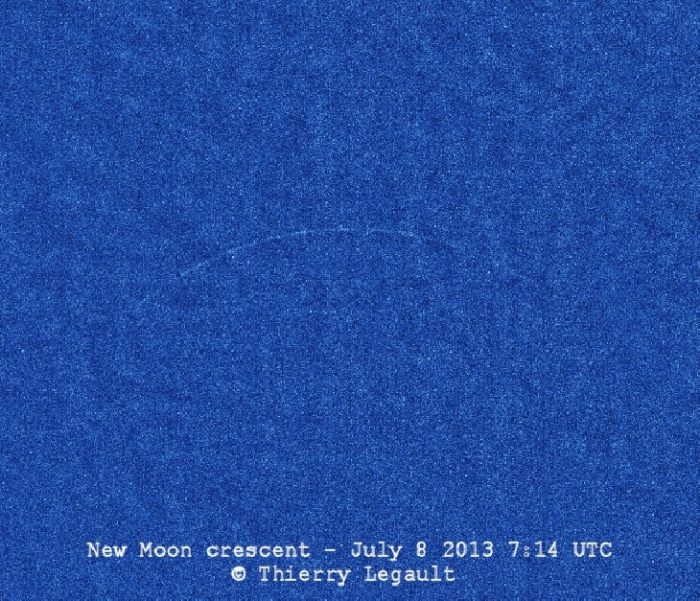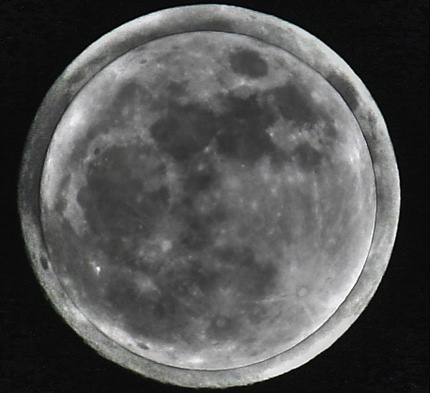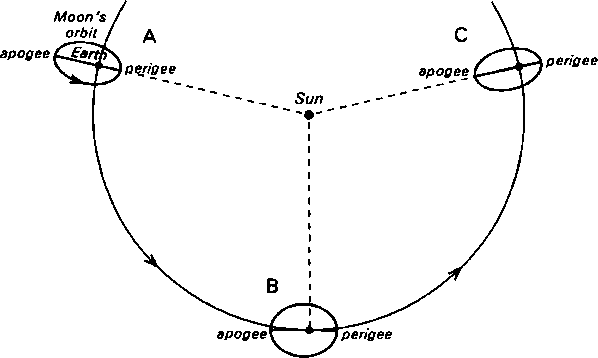
In recent years, the year’s largest supermoon has been a full moon. But not in 2017. The moon will be new on May 25, and it’ll swing to lunar perigee – and be closest to Earth for all of 2017 – about a quarter day later:
May 2017 new moon (most nearly between Earth and sun): May 25 at 19:44 UTC
May 2017 lunar perigee (moon closest to Earth): May 26 at 1:23 UTC
There’s no comparably close alignment of a full moon with lunar perigee this year. So – for the first time since the year 2009 – it’ll be a new moon (not a full moon) that presents the year’s closest and largest supermoon.
We say “largest” despite the fact that you won’t see this moon. We can’t see it because every new moon travels across the sky with the sun during the day. However, if there were a total solar eclipse at this new moon (which there isn’t), it would be a particularly long eclipse, due to this close and large new moon.
Plus this closest and largest supermoon of 2017 will be felt by Earth, in the sense that it will strongly affect earthly tides in days following May 25.
Astronomers sometimes call the year’s nearest perigee moon a proxigee moon.
How close will this May new moon supermoon be? The 2017 proxigee, or closest perigee, moon will lie 357,207 km (221,958 miles) away. That gives 2017 another first since 2009. It’ll be the first time since 2009 that the centers of the Earth and moon will not come closer than 357,000 km (221,830 miles).
View a 2017 lunar perigee and apogee chart here

Why do we have no proxigee full moon in 2017? It’s because – like so many things in the heavens – proxigee full moons happen in predictable cycles. They tend to recur in periods of 14 lunar months (413 days, or 14 returns to full moon), which is considerably longer than one calendar year. The last proxigee full moon came late in the year in 2016. Thus there’s no proxigee full moon in 2017, and the following proxigee full moon will arrive in early 2018.
November 2016:
Full moon: Nov 14 at 13:52 UTC
Proxigee (356,509 km): Nov 14 at 11:23 UTCMay 2017:
New moon: May 25 at 19:44 UTC
Proxigee (357,207 km): May 26 at 1:23 UTCJanuary 2018
Full moon: Jan 2 at 2:24 UTC
Proxigee (356,565 km): Jan 1 at 21:54 UTC
Proxigee full moons often recur in cycles of 14 lunar (synodic) months because 14 lunar months (14 returns to full moon) are nearly commensurate to 15 returns to perigee:
14 lunar months x 29.53059 days = 413.428 days
15 returns to perigee x 27.55455 days = 413.318 days
This 413-day period of time is approximately equal to one year and 48 days. The most recent proxigee full moon (221,524 miles or 356,509 km) took place on November 14, 2016. So the next proxigee full moon won’t happen until after the year 2017 has passed, or on January 2, 2018 (221,559 miles or 356,565 km).

Every proxigee full moon occurs about one year, one month and 18 days later each year, as shown on the list of proxigee full moons from 2010 to 2020 below:
Proxigean full moons from 2010 to 2020
2010 Jan 30 (356,593 km)
2011 Mar 19 (356,575 km)
2012 May 06 (356,955 km)
2013 Jun 23 (356,991 km)
2014 Aug 10 (356,896 km)
2015 Sep 28 (356,877 km)
2016 Nov 14 (356,509 km)
2018 Jan 02 (356,565 km)
2019 Feb 19 (356,761 km)
2020 Apr 08 (356,907 km)
Alas, the proxigee full moon skips the year 2017 altogether because the previous proxigee full moon happened on November 14, 2016, and the following one won’t be until January 2, 2018.

What causes the 14-lunar month proxigee cycle? Because of gravity, and the intriguing interplay of the sun, Earth and moon (and, to a lesser extent, the planets), the closest perigee of any given year is the perigee that aligns most closely with the full moon or new moon.
Also, the year’s farthest apogee is the apogee that most closely aligns with new moon or full moon.
The moon, Earth and sun are aligned at full moon, with Earth in the middle; at new moon the Earth, moon and sun are aligned, with the moon in the middle. At full moon and new moon, the tidal pull of the sun and moon combine to create wide-ranging spring tides. And a full moon or new moon at perigee creates even wider-ranging perigean spring tides.
The diagram below helps to explain why a full moon or a new moon at perigee comes especially close to Earth. Take a careful look. Explanation below.

Ready to get technical? Read on!
On the diagram above, the line connecting lunar perigee with lunar apogee defines the moon’s major axis (the longest axis of an ellipse).
When the moon’s major axis (apogee-perigee line) points sunward (A & C on the diagram), the eccentricity (flatness) of the moon’s orbit increases to a maximum. A greater eccentricity lessens the perigee distance, while increasing the apogee distance.
At A in the diagram, it’s a perigee new moon (supermoon) and an apogee full moon (micro-moon).
Then 3.5 lunar months (some 103 days) later, at B in the diagram, the major axis is at a right angle to the sun-Earth line, so the eccentricity is minimal. At such times, the moon’s orbit is closest to circular. It’s a more distant perigee and closer apogee, with the first quarter and last quarter moons more or less aligning with apogee and perigee.
Then 7 lunar months (206 days) later, the major axis again points sunward. Once again, the eccentricity of the moon’s orbit is increased to a maximum, lessening the perigee distance yet increasing the apogee distance. This time around, however, it’s a full moon perigee and new moon apogee. See C in the diagram.
Because 7 lunar months are nearly commensurate to 7.5 returns to perigee (or apogee), the new moon and full moon trade places relative to apogee and perigee every 7 lunar months. So seven lunar months hence, the new moon will partner up with apogee (instead of perigee) and the full moon will couple up with perigee (rather than apogee). We summarize below:
Dates for closest/farthest new/full moons:
2017 May 25: closest new moon
2017 Jun 09: farthest full moon:Seven lunar months later:
2017 Dec 18: farthest new moon
2018 Jan 02: closest full moon

Bottom line: For the first time since the year 2009, it’ll be the new moon (not the full moon) that gives us the year’s closest and largest supermoon. Depending on your time zone, it’ll happen on May 25 or 26, 2017. Expect higher-than-usual tides in the following days!
Click here to view full moon at perigee and apogee in 2014.
Resources:
Lunar perigee and apogee calculator











